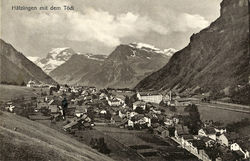Portrait
The village is situated on the main road on the right side of the Grosstal between Haslen and Diesbach. In the south of Hätzingen the Rufi gully flows in the Linth, the hamlet of Tschuepis is located in the north and in the east a part of the Freiberg Kärpf (the oldest game preserve of Switzerland) is part of the village area.
About 1350, the name Hezzinge(n) appears for the first time. It probably means the home of Hazzo what is a short form of a name like Hadu-brand. This term itself means "battle sword" or "good knight". Therefore, the former municipal coat of arms showed an Alemannic warrior. In the late Middle Ages, Hätzingen belonged to the Tagwen Nesselowe. Together with Diesbach, Betschwanden and Haslen, Hätzingen formed a so-called Wahltagwen (voting community) until the 1989 and since 2004 the village is part of the municipality of Luchsingen.
First Hätzingen belonged to the church in Glarus and since the 14th century it belongs to the church in Betschwanden. Since the reformation in 1528 the majority of the citizens are Protestants.
1538 the Grosshaus (large house) was built. It was a warehouse for salt and grain. In the 18th century, the hand spinning was the main source of income for the village. In 1831, the brothers Steuervogt Johann Heinrich Hefti (1790-1862) and Councillor Fridolin Hefti (1793-1854) founded the woolen cloth factory in Hätzingen under the name "Gebrüder Hefti" (brothers Hefti), which was until its closure in 1991 the largest employer in the village. In 1836, Fridolin Hefti was also the first owner of a spinning machine and in 1856 the mechanical weaving plant Hätzingen introduced gas lighting (also as a premiere in Glarus). In 1850, the two brothers purchased premises for a spinning mill. In 1882, the two Hefti families separated. Colonel H. Hefti-Trümpy moved with his three sons to Italy and founded a cotton-spinning and twisting in Roé (province of Brescia). The plants in Hätzingen were bought back by the parent company and operated as spinning. Four factory owner villas - built between 1850 and 1907 - still refer to the wealth of the textile industry at that time. The number of inhabitants of Hätzingen rose to the mid-19th century to 500 and one hundred years later even to 653. On August 3, 1893, the woolen cloth factory was beset by a fire accident. At this event the phrase "Hätzige böös" was to be minted. A "fire horseman" alarmed with his call through all villages until Glarus the fire brigades.
The textile factory also took over the patronage of several club formations: in 1862 of the male choir, in 1884 of the shooting club and in 1895 of the gymnastic club. In 1861, the company also financed the opening of a secondary school. During six years, 73 students from Leuggelbach to Linthal made use of this educational opportunity.
The Georg Bilgeri challenge trophy in cross-country skiing (Georg Bilgeri was an Austrian ski pioneer), which the cloth factory donated for the first time for a 50-kilometer Swiss championship in Linthal in 1950, received international attention. At that time, the Bilgeri cloth for ski sport was the company´s best seller.
Temporarily the number of staff grew to approximately 640, but then continuously dropped. 1981, the number fell below 200 after a year before the spinning mill was closed. In 1986, a Turkish group bought the textile factory but already after five years the operation came to an end and since then factory ruins mint the village picture of Hätzingen. In 2000, more than four-fifths of the labor force were employed in the service sector outside Hätzingen.
The most outstanding employee of the company F. Hefti & Co. was Melchior Hefti (born in 1879). For more than fifty years he worked as a master locksmith. In addition, he held the following functions: 1905-1908 he was Municipal Councillor, 1908-1938 Municipal President, 1910-1920 District Councillor (1918 District President), 1913-1917 Inspection Judge, 1920-1947 Cantonal Councillor (1932-1938 Landamman) and 1938-1953 Councillor of States.
in 1873, the school district Hätzingen had decided to take the secondary school of the textile factory. For the time being the school teaching took place in the primary schoolhouse which was built in 1841, later in the annex to the restaurant "Ochsen" (the first school in Hätzingen is documented for the year 1797). In 1890, Hätzingen built a secundary schoolhouse including an apartment for the teacher (until 2004 it served as the parish hall). 1923, both the secondary and primary students moved into the newly created present school building at the south end of the village. In 1973, the secondary school merged with the school in Linthal.
Already in 1471 Hätzingen had to team up with other valley people to maintain the Höfliegg bridge in Engi according to a decision made by the Landsgemeinde. Only in 1892 Hätzingen was able to redeem itself from this obligation.
Until 1838, the Adlenbach bridge was the only crossing over the river Linth between Hätzingen and Luchsingen. During the construction of a new bridge in the same year Hätzingen experienced a bad surprise. After the scaffolding was eliminated, the vault collapsed. They now created a wooden bridge which was replaced in 1886 by an iron and in 1980 by a concrete one. Because of a correction of the road, the restaurant "Rössli" had to be demolished in 1972. It had been in existence for over 200 years and was most probably one of the first guesthouses in the village.
In 2003 the Runsenkorporation (gully corporation) Hätzingen was founded. In 2004, the welfare community Hätzingen merged with the community Luchsingen. In 1989 almost one-third of the 356 population had been of foreign origin and since 1973, there is a Tibetan colony in Hätzingen.
In 2011, the community structure of canton Glarus was reorganized and Hätzingen became part of the new administrative community Glarus Süd.
Translation of the official website of Hätzingen
Family Names from Hätzingen
Hefti
Heiz
Störi








